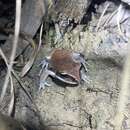Description
(
anglais
)
fourni par AmphibiaWeb articles
Deep brown to chocolate brown dorsum which may possess scattered small black flecks. Thin white or yellow stripe above the upper lip, edged below by a narrower brown stripe extending from the mouth to the base of the forearm. The lower region of the flanks is typically yellow with scattered black spots and flecks. The groin and thighs are characterised by brilliant light blue, blue-green or green colour, with the groin exhibiting scattered black spots.
- Anstis, M. (1994). ''The larval development of Litoria brevipalmata (Anura: Hylidae).'' Memoirs of the Queensland Museum, 37(1), 1-4.
- Hines, H., Mahony, M. and McDonald, K. (1999). ''An assessment of frog declines in wet subtropical Australia.'' Declines and Disappearances of Australian Frogs. A. Campbell, eds., Environment Australia, Canberra, 44-63.
- Lemckert, F., and Slatyer, C. (2002). ''Short-term movements and habitat use by the threatened Green-thighed Frog Litoria brevipalmata (Anura: Hylidae) in mid-coastal New South Wales.'' The Australian Zoologist, 32, 56-61.
- Natrass, A.E.O. and Ingram, G.J. (1993). ''New records of the rare Green-Thighed Frog.'' Memoirs of the Queensland Museum, 33(1), 348.
- auteur
- J.-M. Hero
- auteur
- H. Hines
- auteur
- E. Meyer
- auteur
- F. Lemckert
- auteur
- D. Newell
Distribution and Habitat
(
anglais
)
fourni par AmphibiaWeb articles
From the Cordalba State Forest in South-East Queensland south to the Hawkesbury River approximately 60 km north of Sydney in New South Wales.The extent of occurrence of the species is approximately 72500 km2.Has dramatically decreased at Ourimbah on the Central Coast of New South Wales, but elsewhere there has been no reports of declines or disappearances. Additional populations have been found in Queensland as a result of increased surveying.L. brevipalmata is most commonly found in ephemeral or semi-permanent water bodies within wetter forests and swamps. The species is also known to breed in flooded paddocks or temporary waterholes bordering rainforest or open woodland. Typically these frogs display a preference for low shrubs and leaf litter as sheltering sites.
- auteur
- J.-M. Hero
- auteur
- H. Hines
- auteur
- E. Meyer
- auteur
- F. Lemckert
- auteur
- D. Newell
Life History, Abundance, Activity, and Special Behaviors
(
anglais
)
fourni par AmphibiaWeb articles
Breeding has been observed at any time from September to April, usually after heavy rains. The main period of calling activity extends from November to February. Vocalisation generally lasts for one night, with calling at most sites only occuring once per year. Spawn is laid in loose clumps among water weed. About 500 – 600 eggs are laid. Embryos usually hatch within 24 hours. The tadpole stage lasts for approximately 40 to 100 days.
- auteur
- J.-M. Hero
- auteur
- H. Hines
- auteur
- E. Meyer
- auteur
- F. Lemckert
- auteur
- D. Newell
Life History, Abundance, Activity, and Special Behaviors
(
anglais
)
fourni par AmphibiaWeb articles
Broadly distributed but in isolated populations. Severely fragmented. Loss of habitat and degradation of habitat. Loss of known populations.ThreatsClearing for agriculture and urban development major perturbations to the environment, i.e. inappropriate fire regimes, timber harvesting, weed invasion, forest grazing and alterations to hydrology and water quality.Conservation MeasuresListed as rare in Queensland and vulnerable in New South Wales. Protection of breeding sites in State Forests and National Parks.
- auteur
- J.-M. Hero
- auteur
- H. Hines
- auteur
- E. Meyer
- auteur
- F. Lemckert
- auteur
- D. Newell

